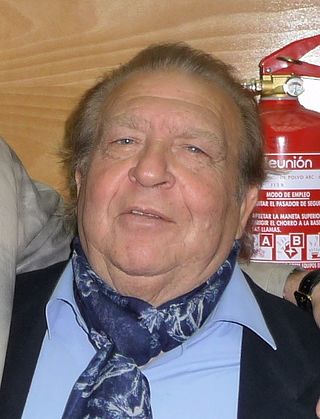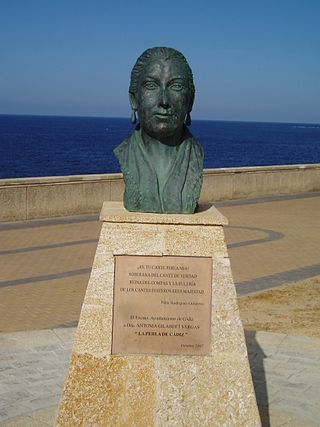
Flamenco is an art form based on the various folkloric music traditions of southern Spain, developed within the gitano subculture of the region of Andalusia, and also having historical presence in Extremadura and Murcia. In a wider sense, the term is used to refer to a variety of both contemporary and traditional musical styles typical of southern Spain. Flamenco is closely associated to the gitanos of the Romani ethnicity who have contributed significantly to its origination and professionalization. However, its style is uniquely Andalusian and flamenco artists have historically included Spaniards of both gitano and non-gitano heritage.

Moraíto Chico was a Flamenco guitarist.

Juan Peña Fernández, also known as Juan Peña "El Lebrijano" or simply El Lebrijano, was a Spanish Gitano (Roma) flamenco musician. As a flamenco-fusion musician he studied the musical relation and fusion of two cultures that coexisted in Spain during the Al-Andalus period.

María Rosa García García, better known as Niña Pastori, is a Spanish flamenco singer (cantaora).

Sara Pereyra Baras is a Spanish flamenco dancer and choreographer born in San Fernando (Cádiz) who has established her own dance company.
The cante flamenco, meaning "flamenco singing", is one of the three main components of flamenco, along with toque and baile (dance). Because the dancer is front and center in a flamenco performance, foreigners often assume the dance is the most important aspect of the art form — in fact, it is the cante which is the heart and soul of the genre. A cante singer is a cantaor or cantaora.
Cristina Hoyos Panadero is a Spanish flamenco dancer, choreographer and actress, born in Seville, Spain. After a successful worldwide career, she opened her own dance company in 1988 that premiered at the Rex Theatre in Paris. She played an important role during the opening and closing ceremonies of the 1992 Summer Olympics in Barcelona.
Shōji Kojima is a Japanese flamenco dancer. Along with Yoko Komatsubara, Kojima is credited as instrumental in popularising flamenco in Japan.

Jairo Barrull Fernández artistically known as Jairo Barrull is a Spanish Gypsy flamenco dancer. He is son of Gypsy flamenco dancer Ramon Barrull, and great great nephew of the flamenco guitarist Diego del Gastor.

Diego del Morao is a gipsy flamenco guitarist. He is the son of the late Moraíto Chico II who he learned to play from and also attended El Carbonero's school. He has recorded live albums such as Confí de fuá, No hay quinto malo and La rosa blanca. He has performed with the likes of José Mercé, José Mercé, Vicente Soto Sordera, and Diego Carrasco.
Vicente Soto Sordera is a flamenco cantaor (singer) who belongs to one of the most important Flamenco families in history, "Los Sordera".

Ana Morales Moreno, known as Ana Morales, is a Spanish flamenco dancer and choreographer, who has established her own dance company.
Antonio Gómez de los Reyes known as Antonio Canales is a male flamenco dancer and choreographer born in Seville.

Antonia La Negra, artistic name of Antonia Rodríguez Moreno, was a Spanish Gitana cantaora and bailaora. Wife of the bailaor Juan Montoya, mother of the singer Lole Montoya, of the duet Lole y Manuel, and grandmother of the singer Alba Molina.
Pilar Montoya Manzano, known as La Faraona, was a Spanish Romani flamenco dancer. A member of the Farrucos family, she was the eldest daughter of dancer Antonio "Farruco" Montoya Flores and singer Enriqueta Reyes, as well as the sister of Rosario "La Farruca" Montoya and the aunt of Juan Manuel "Farruquito" Fernández Montoya, Antonio El Farru, and El Carpeta.

Maruja Troncoso Ortega is a Spanish lyric soprano and professor of singing.

La Perla de Cádiz is the stage name of Antonia Gilabert Vargas, who was a Spanish gypsy (gitana) flamenco singer.
José Cortés Jiménez, known mononymously as Pansequito, was a Spanish flamenco singer.
Merche Esmeralda is a Spanish flamenco dancer (bailaora) and choreographer. In 2007, she was the recipient of the Fundación Cruzcampo "Compás del Cante" Award; this award is always referred to by the Spanish media as the "Flamenco Nobel prize".

Dolores de los Santos Bermúdez is a Spanish Romani flamenco singer. Hailing from a renowned flamenco Romani family, she is the daughter of Manuel de los Santos Pastor, and granddaughter of Agujetas el Viejo.












